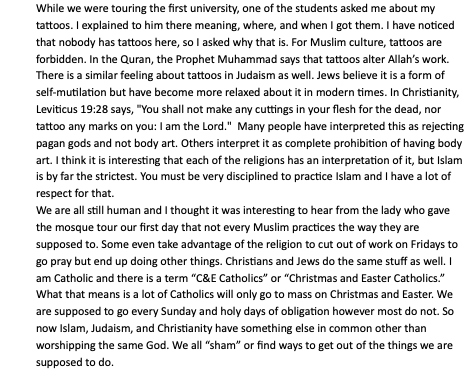Race, Ethnicity, Culture or Religion (Rug Shopping)
When I went rug shopping in Fes recently, I became even more fascinated with these beautiful fabrics when the dealer, Ali, gave me information about their cultural importance. These carpets are more than simply floor coverings in Morocco; they are living relics, each with its own history. Made by women from many tribes, they stand for empowerment, tradition, and legacy. According to Ali, a sizeable percentage of rug sales revenue goes toward supporting the Moroccan women who made the rugs, which gives the rugs' exquisite craftsmanship an emotional touch.
Moroccan-style carpets have characteristic high piles and a luscious softness. They are mostly made of wool. They are highly sought-after for both usefulness and ornament since, in contrast to their counterparts, they have patterns that are both tidy and soothing.
Moroccan rugs have their roots in Northern Africa and the Sahara, where Berber women woven them around 622 AD. These rugs, which were handed down through the years and represented tradition and artistry, graced palaces and hallowed areas. Later, expert artisans such as the Beni Ourain tribe used wool from Atlas mountain sheep and occasionally camel hair. Craftsmen were influenced by an interesting tradition to burn the edges of these rugs to ward off evil spirits.
Moroccan rugs are historical treasures that each have the cultural fingerprint of the tribe who made them. These carpets exhibit versatility and tradition, from the thickness of the weave, which is adapted for different climates, to the adaptable sizes that suit nomadic lifestyles. Expertly crafted by hand by women, these rugs convey complex narratives using symbolic languages and personal accounts, guaranteeing that no two are alike.
LawrenceofLaBrea. (n.d.). The Ultimate Guide to Moroccan Style Rugs from the Experts. Lawrence of La Brea. https://www.lawrenceoflabrea.com/post/the-ultimate-guide-to-moroccan-style-rugs-from-the-experts



Hi Taira! This was a great approach to this topic. These rugs look to be materialistic things, but really are such a strong cultural representation of Morocco. It's beautiful to see how each component of the rug and evry detail have meaning and intention. Moroccan culture is so rich, even with rugs!
ReplyDeleteHello, Tiara! I appreciate your input regarding artisanship and how it is not only an art form but also a large part of culture. I would like to add on that not only do the rugs represent women's work and their roles in the society as artists, but the rugs they make also are a huge part of Islam in Morocco. As we learned from our tour of the Hassan Mosque, each individual praying in the mosque brings their own rug. The carpets are living relics of the people and Islam as they are used in everyday practice. Thanks for sharing!
ReplyDelete